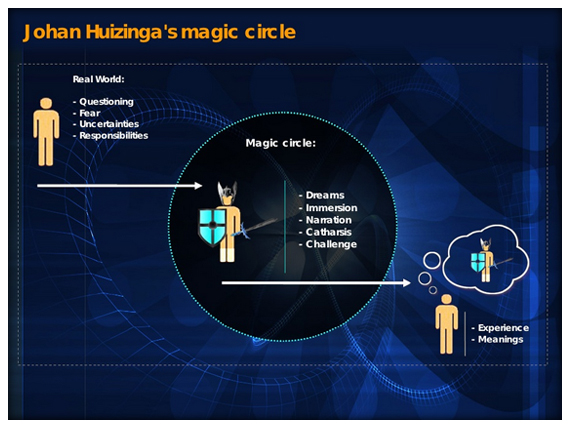In the fields of gaming concepts and game design there's a very important author for reference: I'm talking about Johan Huizinga and in this post I want to discuss a very important concept: the idea of the "magic circle".
Johan Huizinga (1872 – 1945) was a Dutch historian and one of the founders of modern cultural history. In his book "Homo Ludens" (1938) he discusses the possibility that playing is the primary formative element in human culture.
In this book, the author presents the idea of the "magic circle". As described by Adams and Rollings (2009, page 8), Huizinga did not use the term as a generic name for the concept: his text refers to the actual playground, or a physical space for playing.
Inside the magic circle, real-world events have special meanings, as in the example below (ADAMS & ROLLINGS, 2009, page 8):

The magic circle is a place of dreams and fantasy. It's an escape for everyday problems and chores. And the most important: everything inside the magic circle is, in some way, transformative. Each time a person leaves the magic circle they bring meaning and experience.
Huizinga (1955, page 10) wrote that all play moves and have their existance within a playground marked off beforehand, either materially or ideally, deliberately or as a matter of course. Just as there is no formal difference between play and ritual, so the ‘consecrated spot’ cannot be formally distinguished from the playground. The arena, the card-table, the magic circle, the temple, the stage, the screen, the tennis court, the court of justice, etc, are all in form and function playgrounds, i.e. forbidden spots, isolated, hedged round, hallowed, within which special rules obtain. They are all temporary worlds within the ordinary world, dedicated to the performance of an act apart.
In the image below I try to create a visual representation of the idea of the magic circle:

These ideas are essential to study and understand the gaming universe around the players and the impacts of the game culture in the mediatic scene and how important it can be for the contemporary world.
REFERENCES:
ADAMS, Ernest; ROLLINGS, Andrew. Fundamentals of Game Design. New Jersey: Pearson Prentice Hall, 2009
HUIZINGA, Johan. Homo Ludens: A Study of the Play-Element in Culture. Boston: The Beacon Press, 1955.
Johan Huizinga (1872 – 1945) was a Dutch historian and one of the founders of modern cultural history. In his book "Homo Ludens" (1938) he discusses the possibility that playing is the primary formative element in human culture.
In this book, the author presents the idea of the "magic circle". As described by Adams and Rollings (2009, page 8), Huizinga did not use the term as a generic name for the concept: his text refers to the actual playground, or a physical space for playing.
Inside the magic circle, real-world events have special meanings, as in the example below (ADAMS & ROLLINGS, 2009, page 8):

The magic circle is a place of dreams and fantasy. It's an escape for everyday problems and chores. And the most important: everything inside the magic circle is, in some way, transformative. Each time a person leaves the magic circle they bring meaning and experience.
Huizinga (1955, page 10) wrote that all play moves and have their existance within a playground marked off beforehand, either materially or ideally, deliberately or as a matter of course. Just as there is no formal difference between play and ritual, so the ‘consecrated spot’ cannot be formally distinguished from the playground. The arena, the card-table, the magic circle, the temple, the stage, the screen, the tennis court, the court of justice, etc, are all in form and function playgrounds, i.e. forbidden spots, isolated, hedged round, hallowed, within which special rules obtain. They are all temporary worlds within the ordinary world, dedicated to the performance of an act apart.
In the image below I try to create a visual representation of the idea of the magic circle:

These ideas are essential to study and understand the gaming universe around the players and the impacts of the game culture in the mediatic scene and how important it can be for the contemporary world.
REFERENCES:
ADAMS, Ernest; ROLLINGS, Andrew. Fundamentals of Game Design. New Jersey: Pearson Prentice Hall, 2009
HUIZINGA, Johan. Homo Ludens: A Study of the Play-Element in Culture. Boston: The Beacon Press, 1955.

 :.
:.

0 comments:
Post a Comment